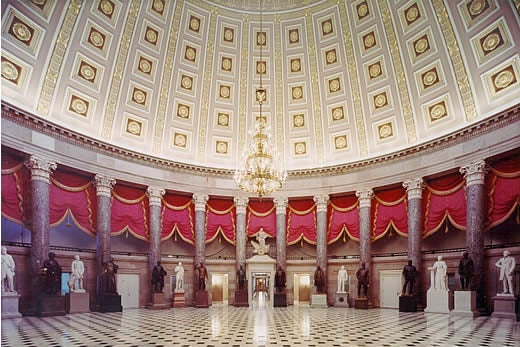Even after the last of the Trumpist mob was driven from the Capitol last week, more than a dozen insurrectionists still occupied what President-elect Joe Biden calls America’s “citadel of liberty.”
Monuments to 10 Confederate soldiers and officials stand within the National Statuary Hall Collection, along with several other rebel portraits and busts throughout the building.
Being carved in stone and cast in bronze, these rebels can no longer physically damage American interests, as did their spiritual descendants last Wednesday. But as long as they remain, the statues will continue to send a deeply destructive message: Sedition against the U.S. government is cause for celebration. It was a message that Trump’s rioters embraced.
Whereas flesh-and-blood neo-Confederates occupied the Capitol for about four hours last week, most of the building’s statuary Confederates have been there for nearly a century.
Ironically, National Statuary Hall, where most of these rebel monuments stand, was the creation of Abraham Lincoln’s Union government during the Civil War. Per a bill signed in 1864, each state was invited to send up to two statues of its local heroes. The first, featuring Nathanael Greene of Rhode Island, was installed in 1870.
Not until 1909 did a former Confederate state erect a monument in Statuary Hall, when Virginia selected the rebel Gen. Robert E. Lee for commemoration. Lee was a predictable choice amid a renaissance in Confederate culture. By that point, the so-called Lost Cause interpretation of the Civil War was in full bloom, and Lee was its patron saint.
According to acolytes of the Lost Cause, the Confederate rebellion was a just war waged against an overweening federal government. Conveniently omitted from most Lost Cause writings was the fact that white Southerners rebelled to protect and expand the institution of slavery. Literary and oratorical apologias for the rebellion were accompanied by a flurry of monuments to Confederate leaders, including those in Statuary Hall. As scholars have argued, the Lost Cause and Jim Crow were two prongs of the same movement to marginalize Black Americans—politically, culturally, and historically.
Soon after Lee’s placement in the Capitol, other Southern states followed Virginia’s example and added insurrectionists to Statuary Hall, which became an American pantheon of sorts. Eventually, more than 10 percent of all figures in the National Statuary Hall Collection featured men who had rebelled against the U.S. government.
A statue of Alexander Stephens arrived in 1927. Stephens had argued in favor of union when his home state of Georgia debated secession in early 1861. But when Georgia left the Union, so too did Stephens. He was named the vice president of the Confederacy and quickly became one of the most ardent champions of rebellion.
He also captured, better than anyone else in the Confederate government, the driving principle behind the rebellion. “Our new government is founded,” he thundered in March 1861, “upon the great truth that the negro is not equal to the white man; that slavery subordination to the superior race is his natural and normal condition.”
Mississippi dedicated its two statues in 1931—both of them Confederates. One commemorates James Zachariah George, a colonel in the Confederate Army who was captured twice during the war. As a U.S. senator from 1881 to 1897, George played a leading role in the campaign to disenfranchise Black men during the post-Reconstruction period. Jefferson Davis, the former president of the Confederacy, was Mississippi’s other contribution to Statuary Hall.
Recently, there has been some movement toward a more representative—and less treasonous—collection of statues in the Capitol. Some of the Confederate leaders, including the statue to George, have been relocated from Statuary Hall itself and placed in less exalted parts of the building, such as the visitor center. In December 2020, the statue to Robert E. Lee was removed.
Until 2018, no state had selected a Black leader for one of its statues. That changed when Florida announced it would replace its statue of Confederate Gen. Edmund Kirby Smith with one honoring Mary McLeod Bethune, a Black educator and civil rights activist.
But the majority of the rebels remain.
And if their ghosts could speak, they likely would have cheered Wednesday’s insurrectionists. After all, Confederates and modern-day rebels have much in common.
Both groups spilled American blood in an attempt to overturn the results of a free and fair presidential election. Both groups thrived on elaborate falsehoods about the justness of their lost causes. And while both groups ultimately failed to topple the duly elected representatives of the United States, they did lasting damage to the nation’s democratic institutions.
Insurgents—whether of the living or the statuary variety—have no place in our democracy’s sacred spaces. It’s time to remove them all.

